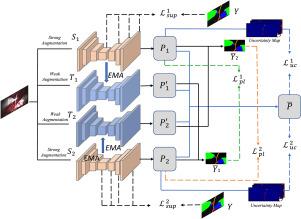UTMT:基于不确定性引导Twin Mean Teacher的手术内镜图像半监督分割
IF 4.9
2区 医学
Q1 ENGINEERING, BIOMEDICAL
引用次数: 0
摘要
手术内镜图像的语义分割在手术技能分析和指导中具有重要作用。基于完全监督学习的深度学习在该任务中取得了显著的成绩,但它依赖于大量具有像素级注释的训练图像,这些图像耗时且难以收集。为了降低标注成本,提出了一种基于不确定性引导双均值教师(UTMT)的半监督分割框架,用于外科内镜图像分割。UTMT有两个并行的师生结构来处理未注释的训练图像,其中每个学生都由伪标签监督,伪标签不仅由其平均老师获得,而且由其同学获得。均值老师和均值同学的结合可以减少单一模型的固有偏差,提高伪标签的质量。此外,考虑到伪标签可能是有噪声的,我们提出了一种基于不确定性的校正方法,以强调从不同网络获得的高置信度伪标签,并抑制不可靠的部分,以获得更强的鲁棒学习。在两个公开的外科内镜图像数据集上的实验结果表明,当只有1%或5%的训练图像被标记时,UTMT显著提高了分割性能,并且优于六种最先进的半监督分割方法。此外,与完全监督学习相比,UTMT在两个数据集上取得了相似的性能,同时将标注成本降低了90%。本文章由计算机程序翻译,如有差异,请以英文原文为准。

UTMT: Semi-supervised segmentation of surgical endoscopic images based on Uncertainty guided Twin Mean Teacher
Semantic segmentation of surgical endoscopic images plays an important role in surgical skill analysis and guidance. Deep learning based on fully supervised learning has achieved remarkable performance in this task, but it relies on a large amount of training images with pixel-level annotations that are time-consuming and difficult to collect. To reduce the annotation cost, we propose a novel semi-supervised segmentation framework based on Uncertainty guided Twin Mean Teacher (UTMT) for surgical endoscopic image segmentation. UTMT has two parallel teacher–student structures to deal with unannotated training images, where each student is supervised by pseudo-labels obtained by not only its mean teacher, but also its fellow student. The combination of mean teacher and fellow student can reduce the inherent bias of a single model and improve the quality of pseudo-labels. In addition, considering that the pseudo-label may be noisy, we propose an uncertainty-based correction method to emphasize high-confidence pseudo-labels obtained from different networks and suppress the unreliable parts for more robust learning. Experimental results on two public surgical endoscopic image datasets demonstrated that UTMT significantly improved the segmentation performance when only 1% or 5% of the training images were labeled, and it outperformed six state-of-the-art semi-supervised segmentation methods. Furthermore, compared with fully supervised learning, UTMT achieved a similar performance while reducing the annotation cost by 90% on the two datasets.
求助全文
通过发布文献求助,成功后即可免费获取论文全文。
去求助
来源期刊

Biomedical Signal Processing and Control
工程技术-工程:生物医学
CiteScore
9.80
自引率
13.70%
发文量
822
审稿时长
4 months
期刊介绍:
Biomedical Signal Processing and Control aims to provide a cross-disciplinary international forum for the interchange of information on research in the measurement and analysis of signals and images in clinical medicine and the biological sciences. Emphasis is placed on contributions dealing with the practical, applications-led research on the use of methods and devices in clinical diagnosis, patient monitoring and management.
Biomedical Signal Processing and Control reflects the main areas in which these methods are being used and developed at the interface of both engineering and clinical science. The scope of the journal is defined to include relevant review papers, technical notes, short communications and letters. Tutorial papers and special issues will also be published.
 求助内容:
求助内容: 应助结果提醒方式:
应助结果提醒方式:


